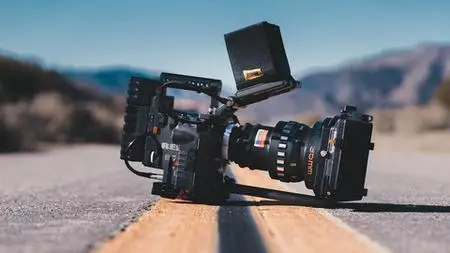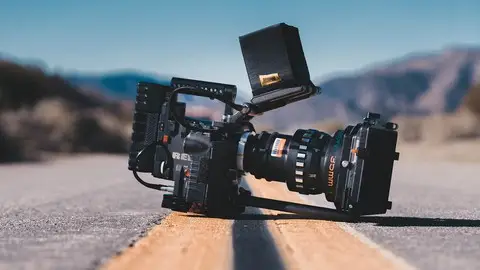Filmmaking For Beginners. Become A Master In Videography.
Published 1/2023
MP4 | Video: h264, 1280x720 | Audio: AAC, 44.1 KHz
Language: English | Size: 2.32 GB | Duration: 2h 1m
Published 1/2023
MP4 | Video: h264, 1280x720 | Audio: AAC, 44.1 KHz
Language: English | Size: 2.32 GB | Duration: 2h 1m
Become a master when it comes to filmmaking, cinematography, visual storytelling, studio lighting and video editing.
What you'll learn
Learn the basics of filmmaking and be a pro at operating the camera.
Identify and create cinematic shots in your own way.
Create depth to get cinematic shots into your sets.
Edit the videos you just shot.
Develop your own cinematography & visual storytelling style.
Requirements
You don't need to know anything about filmmaking. Just have the willing to practice the skills you learned with a camera that could be just your smartphone.
Description
The film is the visual art to tell a story, and it's the way narratives are transformed into true stories, but the true master of this art is the person behind the camera. Learn the basics of filmmaking and be a pro at operating the camera.Learn how to create depth to get cinematic shots into your sets. It doesn't matter if you're creating tutorials, interviews, a film, or even more important video calls, you always need a set. In this class, you're going to learn to create your own film set in your home.The most important part of filmmaking is cinematography and sometimes it's hard to achieve these nice shots.What will I learn?In this class, we’re going to start the filmmaking journey by creating a cinematic shot with the right framing. Then we’re going to understand the importance of camera angles and movement. The next step in filmmaking will be telling a story because the film is the visual art to tell a story. The story is the most important part of filmmaking, and it will be the longest part of this class. We’re going to see how different framing, angles, and movements can tell different emotions and feelings. And to give our videos the last final touch to look professional, we’re going to dive a little bit also into lighting.In this class, we're also going to learn what depth is, create depth with the main light, play around with practical lights and the background to create a more cinematic shot. After this class, you're going to know how to light up your set for film or talking-head shot and get a cinematic shot.Also, this class will cover:Identify what makes a video cinematicTrain the eye to find nice shots (angle, movement, framing, composition)Find the right tools to create cinematic shotsGo into a new place and find the right way of filming to achieve cinematic shotsLight up the set just with sunlight.Working with reflectors and negative fillMoving the camera to create depthUnderstanding the programKeep a clean editingcreate better 2D animationsediting with music correctlyColor correctionTransferring footage to other Adobe AppsFor who is the class intended for?This class is for everyone who is just starting the journey of becoming a filmmaker and want to tell their stories through film. This class is also for every beginner videographer or even a professional who didn't understand how to create depth using lighting.What do I need for this class?For this class youțre just going to need a camera. It could be a smartphone, a camcorder, or even a professional DSLR. The focus in this class is not on video quality, like resolution, but what the camera operator did.If you have any softboxes or film lights (even cheap ones) you can follow this class along, but if not, also a window can do the job. If you have any other lights (like decorative lights, led band, …) you can simply use them as practical lights to create depth.
Overview
Section 1: First steps into filmmaking. Become master at telling a story.
Lecture 1 Introduction
Lecture 2 Framing
Lecture 3 Position the camera
Lecture 4 Camera movement
Lecture 5 Tools to move the camera
Lecture 6 The camera tells it's own story
Lecture 7 The power of the visual story
Lecture 8 Lighting
Lecture 9 Section conclusion
Section 2: Cinematography in Film: Create a cinematic Masterpiece
Lecture 10 Section introduction
Lecture 11 What are compositions and visual storytelling?
Lecture 12 Rule of Thirds
Lecture 13 Golden Ratio
Lecture 14 Leading lines
Lecture 15 Depth of Field
Lecture 16 Colors
Lecture 17 180º Rule
Lecture 18 Camera movements & angles
Lecture 19 Composition types
Lecture 20 Looking point of the viewer
Lecture 21 Visual storytelling
Lecture 22 Section conclusion
Section 3: Introducing into Studio Lighting for Cinematography
Lecture 23 Section introduction
Lecture 24 Keylight
Lecture 25 Backlight
Lecture 26 Creating depth
Lecture 27 Section conclusion
Section 4: Make any set or location cinematic
Lecture 28 Section introduction
Lecture 29 What makes a video cinematic?
Lecture 30 Tools you need to create cinematic shots.
Lecture 31 Using the location's best
Lecture 32 Shot using natural lighting
Lecture 33 Camera movemant & framing
Lecture 34 Section conclusion
Section 5: Introducing into Visual Storytelling in Video & Film
Lecture 35 Section Introduction
Lecture 36 Camera work
Lecture 37 Lighting & Set Design
Lecture 38 Audio
Lecture 39 Editing
Lecture 40 Section Conclusion
Section 6: Video editing in Adobe Premiere Pro from beginner to pro.
Lecture 41 Section introduction
Lecture 42 File management
Lecture 43 Toolbar
Lecture 44 The most important shortkeys
Lecture 45 Keyframing
Lecture 46 Edit with music together
Lecture 47 Stabilization
Lecture 48 Effects & Presets
Lecture 49 Color correction
Lecture 50 Adobe Dynamic Link
Lecture 51 Exporting
Lecture 52 Section conclusion
Section 7: Introducing into Film Directing: Produce your own Movie
Lecture 53 Section introduction
Lecture 54 Idea & Screenplay
Lecture 55 Pre-Production
Lecture 56 Production
Lecture 57 Post-Production
Lecture 58 Sharing
Lecture 59 Section Conclusion
Beginner filmmakers who want to become a pro in this domain.



